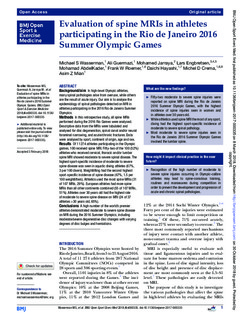| dc.contributor.author | Wasserman, Michael S. | |
| dc.contributor.author | Guermazi, Ali | |
| dc.contributor.author | Jarraya, Mohamed | |
| dc.contributor.author | Engebretsen, Lars | |
| dc.contributor.author | Abdelkader, Mohamad | |
| dc.contributor.author | Roemer, Frank W. | |
| dc.contributor.author | Hayashi, Daichi | |
| dc.contributor.author | Crema, Michel D. | |
| dc.contributor.author | Mian, Asim Z. | |
| dc.date.accessioned | 2018-11-01T13:21:54Z | |
| dc.date.available | 2018-11-01T13:21:54Z | |
| dc.date.created | 2018-10-02T14:37:22Z | |
| dc.date.issued | 2018 | |
| dc.identifier.citation | BMJ Open Sport & Exercise Medicine. 2018, 4, e000335. | nb_NO |
| dc.identifier.issn | 2055-7647 | |
| dc.identifier.uri | http://hdl.handle.net/11250/2570655 | |
| dc.description | This is an Open Access article distributed in accordance with the Creative Commons Attribution Non Commercial (CC BY-NC 4.0) license, which permits others to distribute, remix, adapt, build upon this work non-commercially, and license their derivative works on different terms, provided the original work is properly cited and the use is non-commercial. See: http://creativecommons.org/licenses/by-nc/4.0/ | nb_NO |
| dc.description.abstract | Background/aim: In high-level Olympic athletes, many spinal pathologies arise from overuse, while others are the result of acute injury. Our aim is to analyse the epidemiology of spinal pathologies detected on MRI in athletes participating in the 2016 Rio de Janeiro Summer Olympics. Methods: In this retrospective study, all spine MRIs performed during the 2016 Rio Games were analysed. Descriptive data from the MRIs were tabulated and analysed for disc degeneration, spinal canal and/or neural foraminal narrowing, and acute/chronic fractures. Data were analysed by sport, continent of origin, age and sex. Results: Of 11 274 athletes participating in the Olympic games, 100 received spine MRI. Fifty-two of the 100 (52%) athletes who received cervical, thoracic and/or lumbar spine MRI showed moderate to severe spinal disease. The highest sport-specific incidence of moderate to severe spine disease was seen in aquatic diving athletes (67%, 3 per 100 divers). Weightlifting had the second highest sport-specific incidence of spine disease (67%, 1.5 per 100 weightlifters). Athletics used the most spine MRIs (31 of 107 MRIs, 29%). European athletes had more spine MRIs than all other continents combined (55 of 107 MRIs, 51%). Athletes over 30 years old had the highest rate of moderate to severe spine disease on MRI (24 of 37 athletes >30 years old, 65%). Conclusions: A high number of the world’s premier athletes demonstrated moderate to severe spine disease on MRI during the 2016 Summer Olympics, including moderate/severe degenerative disc changes with varying degrees of disc bulges and herniations. | nb_NO |
| dc.language.iso | eng | nb_NO |
| dc.subject | bowling | |
| dc.subject | olympics | |
| dc.subject | spine | |
| dc.subject | sporting injuries | |
| dc.subject | sports analysis in different types of sports | |
| dc.subject | trauma | |
| dc.subject | young | |
| dc.title | Evaluation of spine MRIs in athletes participating in the Rio de Janeiro 2016 Summer Olympic Games | nb_NO |
| dc.title.alternative | Evaluation of spine MRIs in athletes participating in the Rio de Janeiro 2016 Summer Olympic Games | nb_NO |
| dc.type | Journal article | nb_NO |
| dc.type | Peer reviewed | nb_NO |
| dc.description.version | publishedVersion | nb_NO |
| dc.rights.holder | © Article author(s) (or their employer(s) unless otherwise stated in the text of the article) 2018. | nb_NO |
| dc.source.pagenumber | 7 | nb_NO |
| dc.source.volume | 4 | nb_NO |
| dc.source.journal | BMJ Open Sport & Exercise Medicine | nb_NO |
| dc.source.issue | 1 | nb_NO |
| dc.identifier.doi | 10.1136/bmjsem-2017-000335 | |
| dc.identifier.cristin | 1617254 | |
| dc.description.localcode | Seksjon for idrettsmedisinske fag / Department of Sports Medicine | nb_NO |
| cristin.unitcode | 150,34,0,0 | |
| cristin.unitname | Seksjon for idrettsmedisinske fag | |
| cristin.ispublished | true | |
| cristin.fulltext | original | |
| cristin.qualitycode | 1 | |
